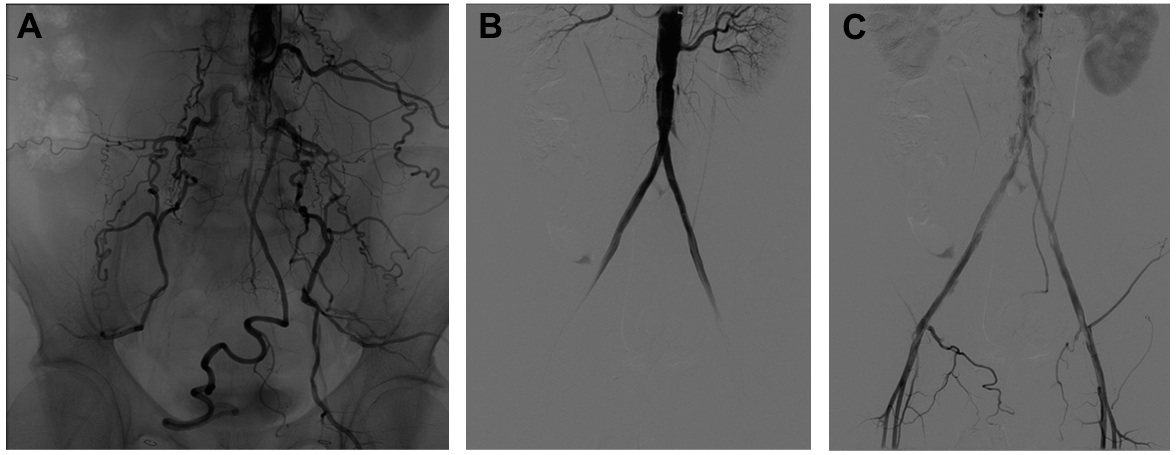Back to 2016 Annual Symposium ePosters
Endovascular Reconstruction for Chronic Infrarenal Aortoiliac Occlusion (CIAO)
Russell J. Pepe, B.A., Priya Patel, B.A., Volodymyr Labinskyy, M.D., Randy Shafritz, M.D., Saum Rahimi, M.D., Naiem Nassiri, M.D..
Rutgers Robert Wood Johnson Medical School, New Brunswick, NJ, USA.
OBJECTIVE - While endovascular reconstruction of TASC II D aortoiliac lesions has been reported with acceptable outcomes, chronic infrarenal aortoiliac occlusion (CIAO) has rarely been treated by endovascular means and is often excluded from reported series. Herein, we describe the technique and short-term outcomes of endovascular reconstruction for CIAO.
METHODS - Patients with CIAO retaining at least a 2-cm infrarenal neck and patent bilateral common femoral arteries (CFA) who presented with severe lifestyle-limiting claudication or rest pain refractory to non-operative therapy underwent endovascular reconstruction using left brachial and bilateral common femoral artery (CFA) access for bidirectional subintimal dissection with/without snare technique for wire access. Aortic bifurcation was reconstructed with kissing balloon-expandable covered stents followed by self-expanding covered stent extensions into the proximal CFA bilaterally. All patients underwent at least an overnight stay in the hospital and were discharged on dual antiplatelet therapy. Data including ankle-brachial index/pulse volume recordings (ABI/PVR), clinical status, symptoms, procedural complications, and patency rates were prospectively gathered and retrospectively reviewed.
RESULTS - Over a 6-month period, 5 patients with CIAO were seen in consultation for revascularization for severe refractory lifestyle-limiting claudication (2) or rest pain (1). Of these, 3 met anatomic criteria for endovascular reconstruction and underwent treatment as described. Technical success rate was 100%. Hospital length of stay (LOS) ranged from 1-4 days (mean 2 days). Follow-up ranged from 6-8 months with 100% primary patency, maintained ABIs, and alleviation of presenting symptoms in all. Complications included 1 self-limited retroperitoneal hematoma treated by in-house observation.
CONCLUSIONS - This technique extends the reach of endovascular therapy to the most severe subcategory of TASC II D aortoiliac occlusive disease in anatomically suitable candidates and is a viable alternative to aortobifemoral bypass for CIAO with potential for considerable reduction in morbidity and hospital LOS. Long-term follow-up of larger cohorts is needed to verify clinical efficacy.
Figure 1. A: Transbrachial angiogram confirming CIAO from the mid infrarenal abdominal aorta to the CFA bilaterally. The latter reconstituted late via a rich collateral network. B/C: Completion angiogram demonstrating successful reconstitution of in-line flow into bilateral CFAs, with ABI normalization and palpable pedal pulses bilaterally. 
Back to 2016 Annual Symposium ePosters
|







